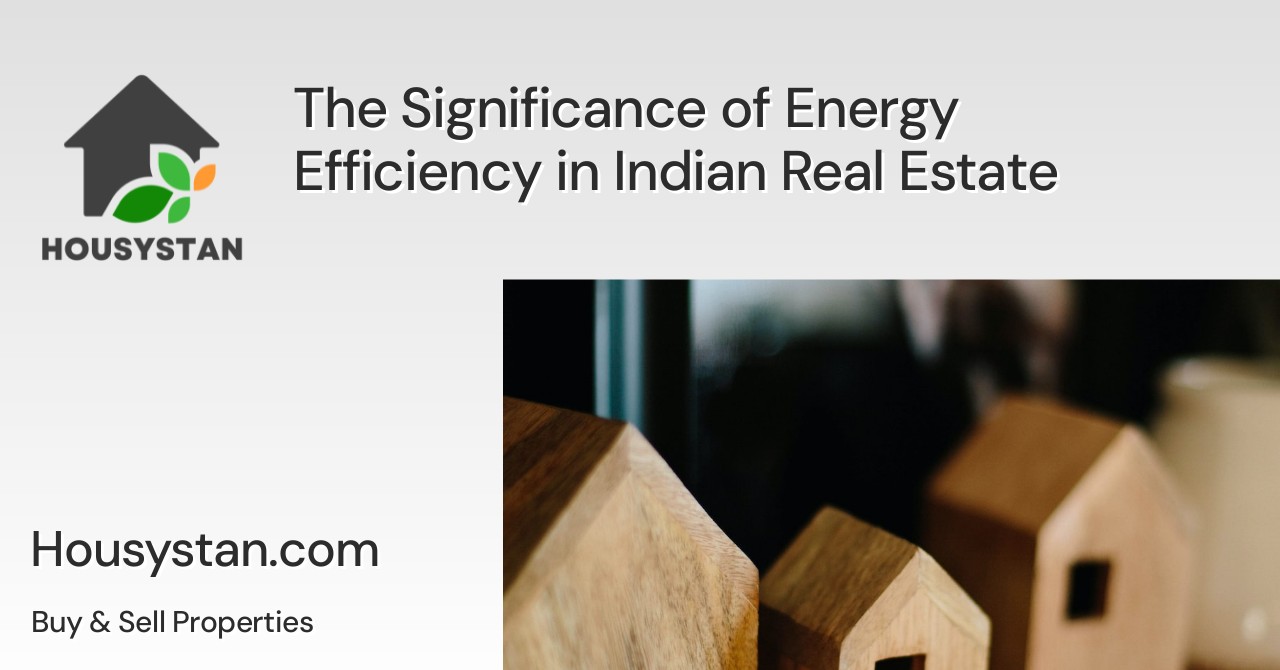The Significance of Energy Efficiency in Indian Real Estate
Read latest blogs and articles from Housystan

The Information mentioned here was last updated on:
4/12/2025Unlocking the Future: The Significance of Energy Efficiency in Indian Real Estate
India, with its rapidly growing population and booming economy, has witnessed an unprecedented rise in its real estate sector. However, as the nation urbanizes, the demand for energy is surging, leading to higher electricity costs and environmental concerns. This has placed a spotlight on energy efficiency as a crucial aspect of modern Indian real estate. Not only does it offer potential savings on utility bills, but it also contributes to environmental conservation, aligning with global sustainability goals.
Understanding Energy Efficiency in Real Estate
- Verified Tenants/Buyers
- Unlimited Property Listing
- Zero subscription/charges fee
When discussing energy efficiency in real estate, we refer to the process of reducing energy consumption while maintaining the same level of service in buildings. This can include everything from incorporating energy-efficient appliances and lighting to using sustainable building materials and advanced heating and cooling systems.
Why Is Energy Efficiency Important?
1. Economic Benefits
- Reduced Utility Bills: Energy-efficient homes and commercial buildings consume less power, leading to significant savings on electricity bills.
- Increased Property Value: Properties with energy-efficient certifications are more desirable, often fetching higher market prices.
- Government Incentives: Various Indian government schemes and incentives encourage the adoption of energy-efficient practices, offering financial benefits to property developers and homeowners alike.
2. Environmental Impacts
- Reduced Carbon Footprint: Energy-efficient buildings contribute to a lower carbon footprint, helping to combat climate change.
- Conservation of Natural Resources: By reducing energy consumption, the demand on power plants decreases, conserving valuable natural resources such as coal and water.
- Promotion of Sustainable Living: Energy efficiency aligns with the global shift towards sustainability, promoting a lifestyle that conserves resources for future generations.
3. Enhanced Quality of Life
- Improved Indoor Air Quality: Efficient buildings often have better ventilation systems, leading to healthier indoor environments.
- Enhanced Comfort: Energy-efficient design often leads to more consistent indoor temperatures and reduced noise pollution.
- Smart Living: Many energy-efficient buildings incorporate smart technology that improves convenience and control for residents.
Key Elements of Energy Efficiency in Real Estate
To achieve energy efficiency, the real estate sector focuses on several key elements:
1. Building Design and Orientation
- Buildings designed with energy efficiency in mind often incorporate natural lighting and ventilation to reduce reliance on artificial systems.
- Strategic orientation can optimize solar gain, reducing heating costs in winter and cooling needs in summer.
2. Use of Energy-efficient Materials
- Insulation: Proper insulation in walls, roofs, and floors can drastically cut energy costs.
- Windows and Doors: Double-glazed windows and well-sealed doors prevent energy loss.
3. Efficient Heating, Ventilation, and Air Conditioning (HVAC) Systems
- Advanced HVAC systems offer more efficient climate control.
- Regular maintenance and technically sound installations further boost energy savings.
4. Integration of Renewable Energy Sources
- Solar Panels: Increasingly popular, solar panels generate renewable energy, reducing reliance on traditional power sources.
- Wind and Biomass: Where feasible, these alternative energy sources are being integrated into buildings to support sustainability.
5. Smart Technology and Automation
- Automated systems can optimize energy use by adjusting lighting, heating, and cooling based on occupancy.
- Smart meters provide real-time data to help consumers make informed energy choices.
Laws and Regulations Promoting Energy Efficiency
India has implemented several policies to promote energy efficiency in real estate:
- Energy Conservation Building Code (ECBC): This sets minimum energy performance standards for buildings.
- National Building Code: Updated regularly, it incorporates guidelines for sustainable construction practices.
- State-level Incentives: Various states offer additional incentives for energy-efficient buildings, reducing the burden on developers and buyers.
For more detailed guidelines, homeowners and builders can refer to local government websites or reach out to local energy efficiency consultants.
Challenges in Implementing Energy Efficiency
While the benefits are clear, the path to widespread energy efficiency in Indian real estate is not without challenges:
- High Initial Costs: The upfront investment in energy-efficient designs and systems can be daunting for developers and homeowners.
- Lack of Awareness: Many stakeholders remain unaware or skeptical about the long-term benefits of energy efficiency.
- Technical Challenges: Implementing sophisticated energy solutions often requires skilled labor and expertise, which can be a barrier in some regions.
By addressing these challenges through education and support, stakeholders in the Indian real estate sector can unlock the myriad benefits of energy efficiency.
The Role of Stakeholders in Promoting Energy Efficiency
Achieving energy efficiency in real estate requires a collaborative effort from all stakeholders:
- Developers and Builders: Must prioritize energy-efficient designs and technologies from the outset.
- Government Bodies: Should continue to offer incentives and enforce regulations that promote energy efficiency.
- Homebuyers and Tenants: Encouraged to demand energy-efficient homes, raising market standards.
- Energy Consultants and Engineers: Play a key role in designing and implementing effective energy solutions.
As the importance of energy efficiency becomes more recognized, the Indian real estate market is poised to lead the charge towards a sustainable future.
For readers wanting to delve deeper into energy-efficient practices and how they can be integrated into their homes or projects, a wealth of resources is available online, including governmental energy agencies and environmental NGOs focused on sustainable living.
By understanding and implementing these practices, stakeholders can help India address its growing energy demands while ensuring a cleaner, greener, and more sustainable built environment.
[Meta Description] Discover the transformative impact of energy efficiency in Indian real estate. Learn how it reduces costs, enhances property value, and supports environmental sustainability without technical jargon.